Blondel Pinnock ’90 is leading a new era of community development in Central Brooklyn.
Columbia College | Columbia University in the City of New York
Blondel Pinnock ’90 is leading a new era of community development in Central Brooklyn.

Restoration CEO Blondel Pinnock ’90
Photographs by Jörg Meyer
The choice of location for the announcement wasn’t just — well, theater. The Billie, as it’s affectionately known, is located in Restoration Plaza, a sprawling mixed-use space superintended by the Bedford Stuyvesant Restoration Corp., the nation’s first community development organization. Restoration was founded in 1967, when its namesake neighborhood had become a national symbol of urban blight and racial disparity; in the years since it has served as a major force for economic, cultural and educational improvements. Put another way, the nonprofit was a pioneer in exactly the type of public-private partnership the EOC is pursuing.
“All across our nation there are places like Bed-Stuy — reservoirs of ambition and aspiration — just waiting to be tapped,” Harris said. “Because of [Restoration’s] success it remains not only the first, but a model for all the rest.”
For Restoration CEO Blondel Pinnock ’90, who introduced the Vice President at the event, being in the national spotlight crystallized the significance of the role she’d begun less than a month earlier. “Before, I’d viewed it as, ‘I’m up to this challenge. All the things that Restoration touches are in my toolchest,’” Pinnock says. “Then you have a moment like that, which reminds you of the greatness of this organization and its history — and what it means to sit in this seat.”
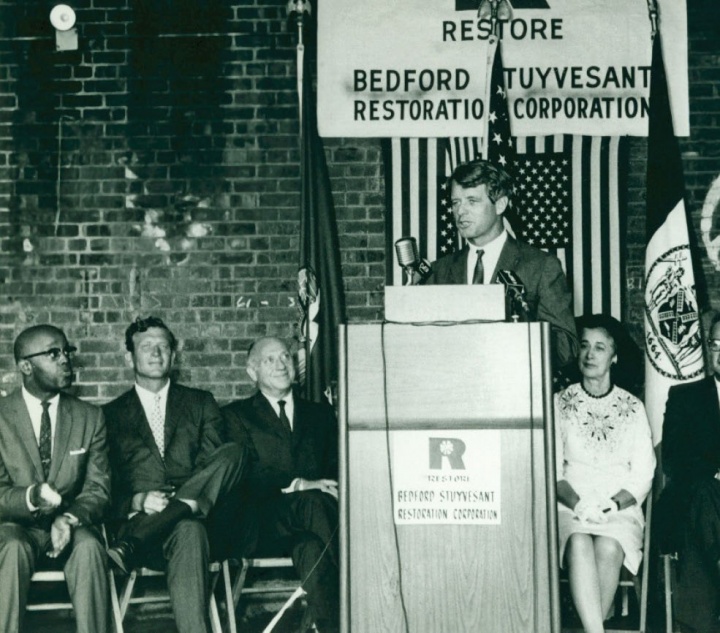
Sen. Robert F. Kennedy announces a new model of community development, circa 1967.
ARCHIVAL PHOTOS COURTESY BEDFORD STUYVESANT RESTORATION CORP.
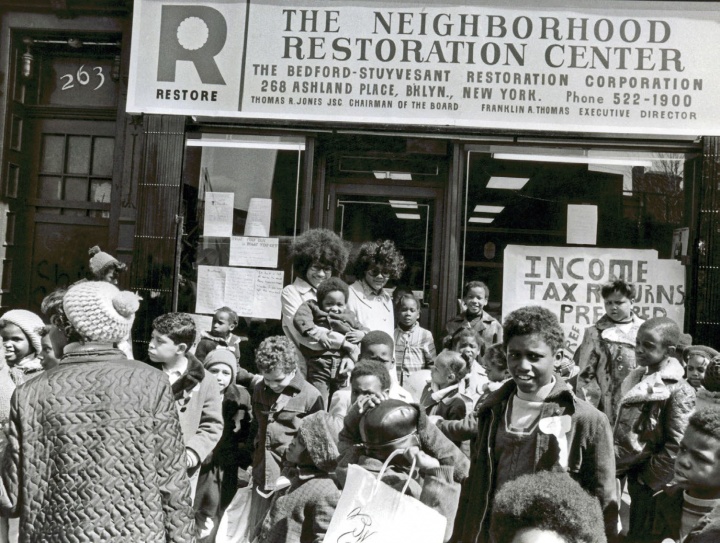
Children gather for Restoration’s annual Easter Egg Hunt in 1973.
These days, Bed-Stuy is one of the fastest gentrifying neighborhoods in the United States, with escalating rents and home values that are becoming untenable for long-term residents. Pinnock’s predecessor Colvin Grannum recognized that Restoration needed an economic mobility platform for the current era, one focused on generating Black wealth at a level that was livable for the area.
Pinnock is charged with steering the plan Grannum initiated to fruition. It’s headlined by an ambitious renovation and expansion of Restoration Plaza, creating an 840,000-square-foot site to be called Restoration Innovation Campus. The design is by architect David Adjaye, whose credits include the National Museum of African American History & Culture in Washington, D.C. It reflects a commitment to four pillars: putting arts and culture front and center, offering employment and educational opportunities for young people, maintaining open space, and having meaningful retail that will benefit the community.
A new tower will be dedicated to technology jobs training, which Pinnock believes is a necessary emphasis. “We have tech hubs now in downtown Brooklyn, in the Navy Yard, in Industry City,” she says. “We’re saying we should have a technology ecosystem right here in Central Brooklyn, and that it could be a catalyst for the creation of Black wealth.” Pinnock notes that the racial wealth gap, which has long existed, was exacerbated by the Covid-19 pandemic; in Brooklyn, it’s currently estimated to be $40–$50 billion.
“We know that we need to help this community make a difference and try to bridge that the best that we can,” she says. “These are the opportunities that young people in this community need.”
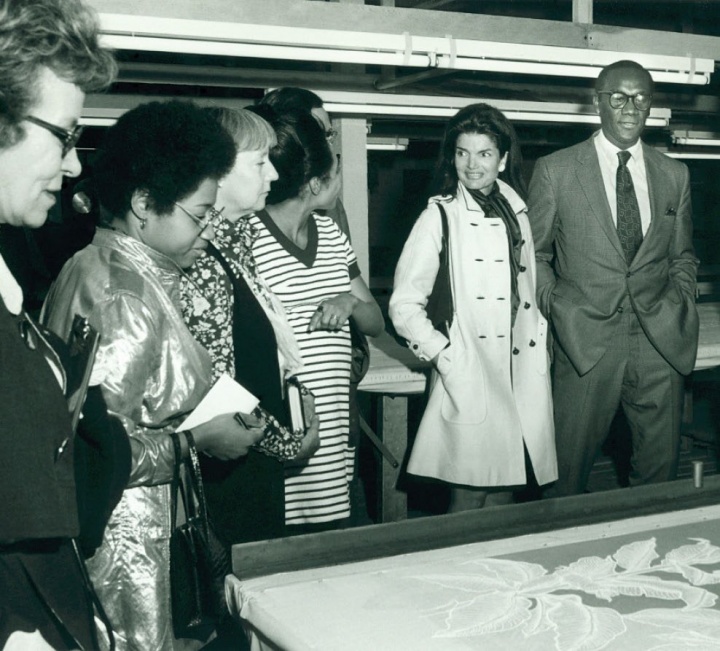
Jacqueline Kennedy Onassis and Franklin A. Thomas ’56, LAW’63 (right) tour Design Works, a Restoration program created to amplify the talents of artists living in Bedford-Stuyvesant. Photo circa 1970.
Pinnock brings up this connection during our interview in Restoration’s headquarters: “It makes me wonder, what is it about Columbia that makes us want to do this type of work? I think it says a lot about what we’re taught and why we do some of what we do.
“When I look at some of my College peers and the work that they’re doing, it all seems to be this good work — ‘the good trouble,’” she continues, quoting Rep. John Lewis. “These are people who could be anywhere and do anything, but clearly we want to make sure that we’re having an impact on our communities, on our neighborhoods, in some cases on our cities — that we’re using our talents to make sure that people are receiving equity.”
“We’re saying we should have a technology ecosystem right here in Central Brooklyn, and that it could be a catalyst for the creation of Black wealth.”
Pinnock originally thought she’d do that good work as an attorney. The native Bronxite chose the College because it was “the best local school” and she wanted to be near her parents, Jamaican immigrants who were older and relied heavily on her. She pursued her career interests outside of class, notably interning for Law School professors Kendall Thomas LAW’83 and Kellis Parker.
“Kellis was really at the forefront of creating race in law,” Pinnock says. “It was the beginning of what people now call critical race theory.” She recalls seeing legal scholars and civil rights activists Derrick Bell, Kimberlé Crenshaw and Lani Guinier come through his office. “They’d all be talking about the work they were doing in this space; I was privileged to be sitting there,” she says. At Columbia Pinnock also revived the defunct Charles Hamilton Houston Pre-Law Society, wanting to do her part to encourage minority representation in legal careers (Houston was the NAACP’s first general counsel).
Pinnock went to Hofstra Law, the only time she has ever lived outside of the city. But after graduation and several years of law firm life, she was surprised to discover a new love: real estate. She took the first of several leaps of faith, as she puts it, and landed at the New York City Department of Housing Preservation and Development. “It was one of the best decisions I made,” she says, “because I had the opportunity to learn about city government and how to use public policy to shape the creation of neighborhoods from an economic development standpoint.”
After three years, much of it spent working with affordable housing developers in Harlem, Washington Heights and the outer boroughs, Pinnock wanted to understand more about loans: “How do developers get money, and who makes the decisions?”
To answer those questions she took another leap, this time into banking. She spent 10 years each at Fleet (which later merged with Bank of America) and Carver Federal Savings Bank. The experience was a little bit David and Goliath, says Pinnock, “going to one of the smallest banks from a major, multinational institution. But at that time [Carver] was the largest Black-managed and Black-run bank in the country. It had been around for 55 or 60 years — it was known in the community as the bank for Black people.
“I was able to be part of so many projects and programs,” she adds, “in particular in Harlem, the Bronx and Brooklyn, and to see how developers and the city come together to fix blight and to create communities and neighborhoods. I loved being part of that community development ecosystem.”
Pinnock eventually started her own consultancy, then entered the nonprofit world for the first time as COO of the Greater Jamaica Development Corp., a community-building organization in Queens. She was there almost three years; its mission was similar to Restoration’s — so much, notes Pinnock, that when the opportunity to apply came along, “the former CEO there was the one who said, ‘You should go for it.’”
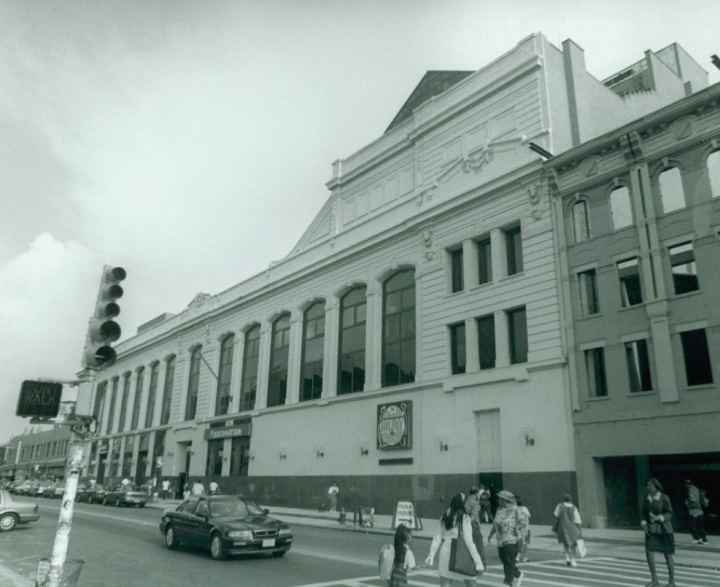
Restoration renovated the Sheffield Farms milk bottling plant for its headquarters, seen here circa 1975.
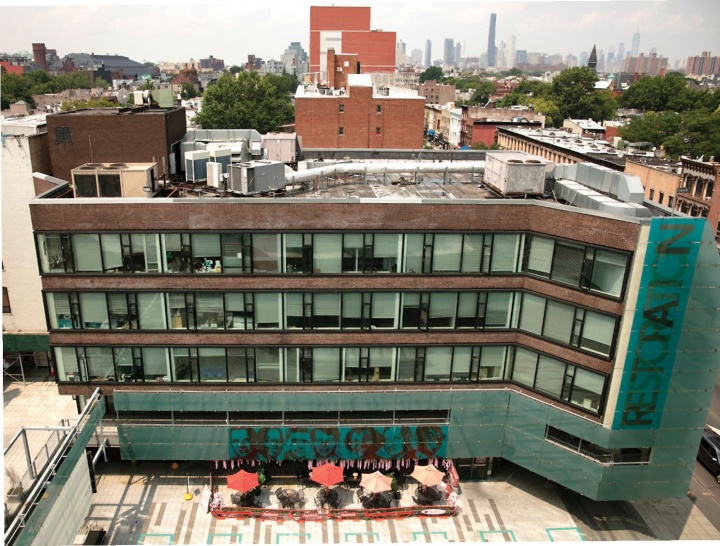
The Applebee’s in Restoration Plaza was the first sit- down restaurant in the neighborhood.
For those who prefer data to anecdote, Restoration’s success can be illustrated with any number of statistics: It has found jobs for more than 24,000 youths and adults, constructed or renovated more than 7,500 housing units and provided $60 million in mortgage financing to nearly 1,500 homeowners. (At its height, Restoration was the second largest real estate owner in Brooklyn, after the City of New York.) Its scope also encompasses financial empowerment and youth services, health and fitness, environmental awareness and small business assistance.
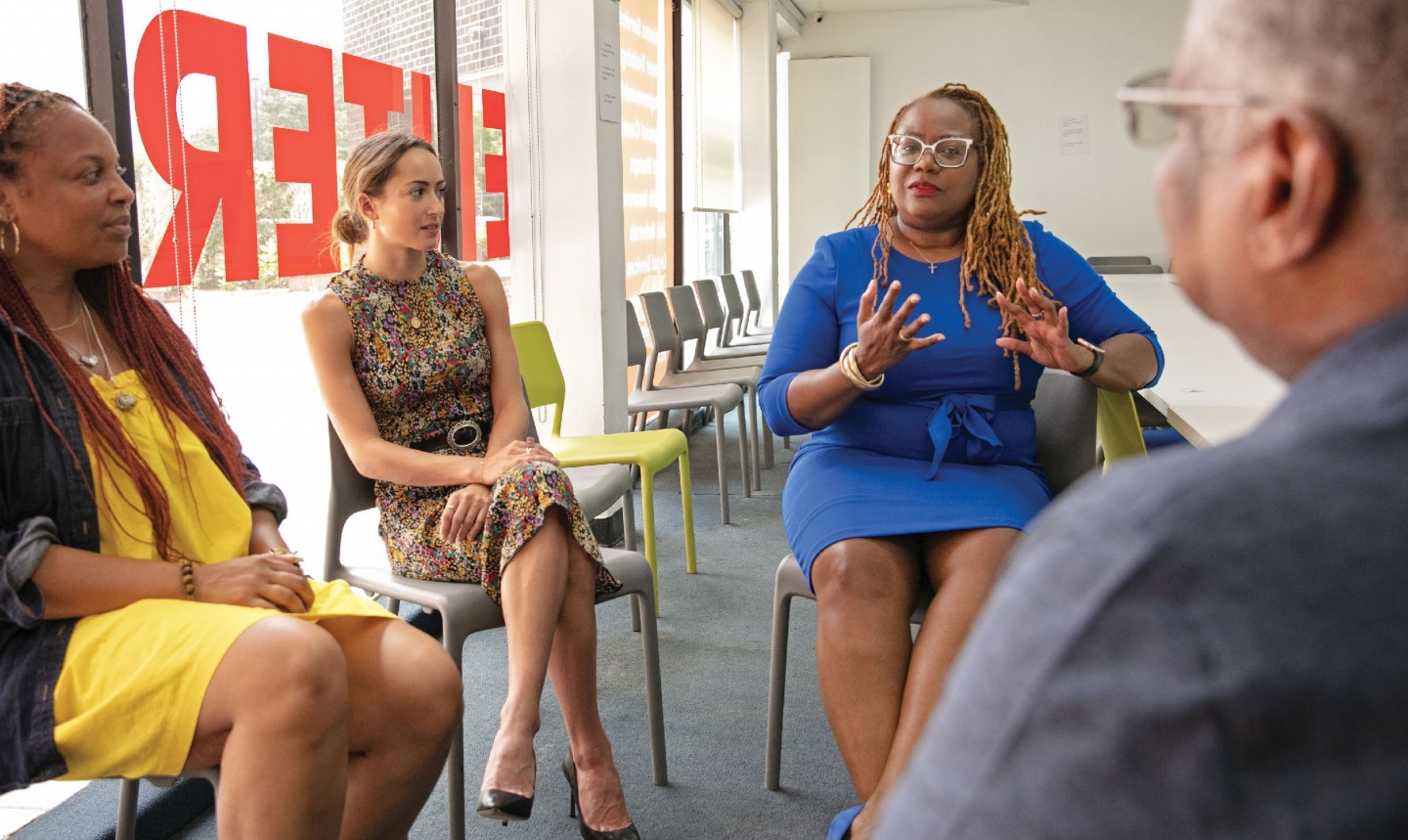
Pinnock oversees a $15 million budget and about 105 full-time employees.
Pinnock is especially proud of Restoration’s commitment to arts and culture, evidenced most prominently through its stewardship of the Billie. Opened in 1972, the theater has its own storied history, with a mission of offering artistic freedom to artists of African descent and providing audiences with complete and authentic portrayals of Black experiences worldwide. Debbie Allen, Samuel L. Jackson and Smokey Robinson have all performed there. In March, Pinnock traveled to the White House to accept a National Medal of Arts from President Biden on the Billie’s behalf, “for being an artistic jewel of the nation.”
“I appreciate that in the beginning — whatever was being discussed about community building — that there was a voice that said, ‘You also need the arts,’” says Pinnock, herself a talented singer and former pianist (she attended the music and arts school that became LaGuardia H.S.). “You need to have an outlet for people to be able to see themselves on stage and to be able to experience and share their stories.” She welcomes the perks of proximity. “We had Nikole Hannah-Jones, from ‘The 1619 Project,’ here the other day, doing a talkback. When you’re having a hard day, to be able to go downstairs and see a play or performance, that can be a real highlight.”
Pinnock has all the responsibilities that come with overseeing a major nonprofit: It has a budget around $15 million and about 105 full-time and 20 part-time employees. “We have to do all the things to make sure the organization stays relevant in this community and that we are providing the programming that’s needed,” she says. She ticks through a few examples including tax prep, workforce development and home weatherization programs. “Restoration falls into this space where, if there’s a community need, we have been there to fill it.”
Pinnock has also spent the past year on something of a local listening tour. When the plans for Innovation Campus began in 2019, a series of community focus groups were held to learn what residents wanted and needed in the neighborhood. Then came the pandemic. “From 2019 to 2023, in the world of Covid, is a lot of years,” she says. “Part of my remit is to talk to the community about what’s changed — is there anything else they would like to see us do on this campus in addition to the things that were said before? We can’t assume we know what they want. But really take a pulse and find out what the community is looking for today.”
Restoration is still a few years from breaking ground on the new campus, but Pinnock is unfazed by the timeline. “The work that we’re doing on the ground today is what’s going to get that project done,” she says. “Almost every week we’re talking to the project management team, the architectural team, our counsel, our fundraisers. We have timelines and deadlines that we need to make to move this project forward. I welcome that work — that’s the visionary piece.
“It’s exciting. One of the reasons I took this job is to be part of the new era of Restoration.”

Published three times a year by Columbia College for alumni, students, faculty, parents and friends.
Columbia Alumni Center
622 W. 113th St., MC 4530, 6th Fl.
New York, NY 10025
212-851-7852
cct@columbia.edu

Columbia Alumni Center
622 W. 113th St., MC 4530, 4th Fl.
New York, NY 10025
212-851-7488
ccalumni@columbia.edu